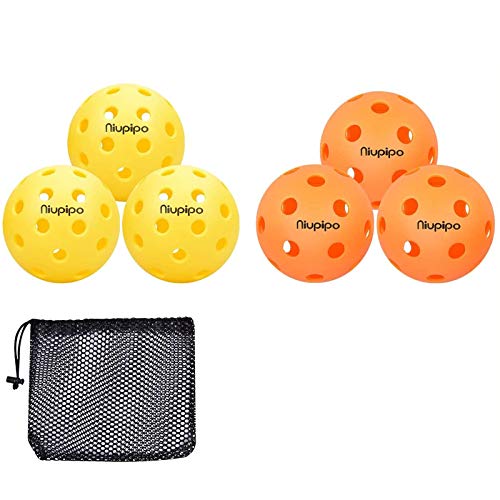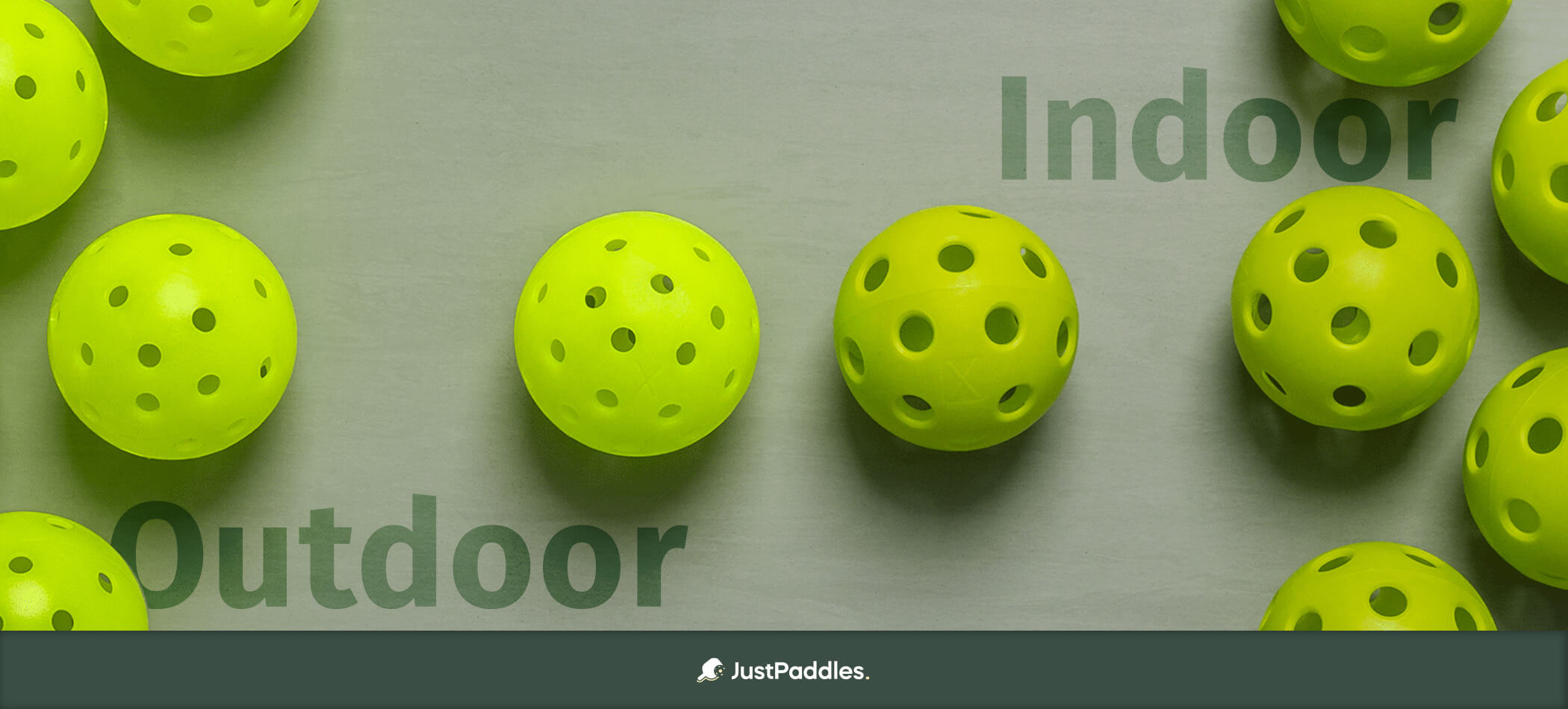Indoor pickleballs are designed for use on smooth courts and have larger holes, while outdoor pickleballs are heavier and more durable to withstand rough surfaces and elements. When it comes to the difference between indoor and outdoor pickleballs, the main distinction lies in their design and construction.
Indoor pickleballs are optimized for smooth courts and have larger holes, allowing for more accurate shots and a better bounce. On the other hand, outdoor pickleballs are heavier and more durable, designed to withstand rougher surfaces and elements such as wind.
This makes them suitable for outdoor play. It’s important to use the right type of pickleball based on the playing surface to ensure optimal performance and gameplay.
Understanding The Distinctions
Indoor And Outdoor Pickleballs: A Brief Explanation
When it comes to the game of pickleball, it’s important to understand the distinctions between indoor and outdoor pickleballs. These differences can significantly impact your playing experience and performance on the court. In this section, we will delve into the key differences in material and construction as well as the impact of the playing surface on pickleball performance.
Key Differences In Material And Construction
| Indoor Pickleballs | Outdoor Pickleballs |
|---|---|
| Lighter in weight | Heavier and more durable |
| Larger holes | Smaller holes |
| Optimized for performance on smooth courts | Designed to withstand rougher surfaces, wind, and elements |
Indoor pickleballs are specifically crafted for playing on smooth indoor courts. They are lighter in weight and have larger holes compared to their outdoor counterparts. The larger holes in indoor pickleballs contribute to a slower pace and higher bounce, allowing players to have better control over the ball during indoor play.
On the other hand, outdoor pickleballs are designed to withstand outdoor conditions, including rough surfaces, wind, and elements. They are heavier and more durable, making them suitable for use on a variety of outdoor courts. The smaller holes in outdoor pickleballs contribute to a faster pace and lower bounce, allowing for better performance in outdoor environments.
The Impact Of Playing Surface On Pickleball Performance
The type of surface you play on can greatly impact your pickleball performance. Indoor pickleballs are optimized for smooth courts found in gymnasiums or indoor facilities. The smooth surface allows for better control and maneuverability, and the light weight of the indoor pickleball makes it easier to make precise shots.
On the other hand, outdoor pickleballs are designed to handle the rougher surfaces commonly found in outdoor courts. These surfaces may include concrete, asphalt, or even gravel. The heavier weight and durability of outdoor pickleballs enable them to withstand the wear and tear of outdoor play, ensuring a consistent bounce and performance.
It’s important to note that using the wrong type of pickleball for a specific playing surface can impact your game and overall experience. For example, using an indoor pickleball on an outdoor court may result in a lack of control and stability due to its lighter weight. Conversely, using an outdoor pickleball on an indoor court may cause the ball to bounce too low and move too fast, making it difficult to execute precise shots.
Characteristics Of Indoor Pickleballs
html
Construction And Materials Of Indoor Pickleballs
Indoor pickleballs are specifically designed for use in indoor court settings. They are crafted using different construction and materials compared to outdoor pickleballs. The construction of indoor pickleballs generally involves a one-piece design with larger holes. These holes contribute to the overall weight and bounce characteristics of indoor pickleballs.
How Indoor Pickleballs Differ In Weight And Bounce
Compared to outdoor pickleballs, indoor pickleballs are lighter in weight. The reduced weight allows for better control and maneuverability in indoor court environments. Additionally, indoor pickleballs tend to have a higher bounce. This higher bounce is beneficial for indoor play as it allows for longer rallies and strategic shot placement.
The Advantages And Disadvantages Of Using Indoor Pickleballs
Using indoor pickleballs offers several advantages for players. The lighter weight of indoor pickleballs allows for quicker shots and more precise control. The higher bounce provides players with more time to react and strategize their shots during rallies. Additionally, the larger holes in indoor pickleballs promote improved spin and ball rotation.
However, there are a few disadvantages to using indoor pickleballs as well. The larger holes in indoor pickleballs may result in higher wind interference during outdoor play, affecting the ball’s trajectory and accuracy. Indoor pickleballs are not designed to withstand rough surfaces and outdoor elements, so using them in outdoor settings may lead to quicker wear and tear on the balls.
Overall, understanding the characteristics of indoor pickleballs is crucial for players to choose the right ball for their preferred playing conditions. Whether it’s the construction and materials, weight and bounce characteristics, or the advantages and disadvantages, being aware of these differences allows players to optimize their performance on indoor courts.
Characteristics Of Outdoor Pickleballs
Construction And Materials Of Outdoor Pickleballs
When it comes to outdoor pickleballs, their construction and materials are specifically designed to enhance their durability and resilience against rough surfaces, wind, and various weather conditions. Outdoor pickleballs are typically made with a sturdy plastic material, such as polyethylene or polypropylene, that can withstand the effects of outdoor play.
How Outdoor Pickleballs Differ In Weight And Bounce
Compared to their indoor counterparts, outdoor pickleballs are heavier to withstand outdoor elements and wind interference. The added weight provides greater stability and control during outdoor play. Additionally, outdoor pickleballs have a lower bounce height, which helps compensate for wind and allows for more predictable shots.
The Advantages And Disadvantages Of Using Outdoor Pickleballs
Using outdoor pickleballs offers several advantages. Firstly, their durability makes them highly resistant to wear and tear, resulting in a longer lifespan. Secondly, the heavier weight provides players with added control and stability, allowing for more precise shots. Lastly, their lower bounce height helps players adjust to outdoor conditions and maintain consistency in their gameplay.
However, there are some disadvantages to using outdoor pickleballs as well. The heavier weight can require players to adjust their technique and swing to adapt to the ball’s characteristics. Additionally, the lower bounce height can make it more challenging for beginners to develop their skills and generate power in their shots. Lastly, the firmer construction of outdoor pickleballs may result in a harder impact on the paddle, potentially causing discomfort for players with sensitive wrists or arms.
Choosing The Right Pickleballs For Your Game
html
Factors To Consider When Selecting Pickleballs
When choosing pickleballs for your game, it is important to consider a few key factors. These factors will help you determine which type of pickleballs, whether indoor or outdoor, best suit your needs. Here are some factors to consider:
- Playing Surface: Consider the surface where you will be playing pickleball. If you play predominantly on indoor courts, then indoor pickleballs will be suitable. On the other hand, if you primarily play outdoor pickleball, then outdoor pickleballs are the ideal choice.
- Durability: Pickleballs designed for outdoor use are typically more durable as they are built to withstand rough surfaces, wind, and other environmental factors. Indoor pickleballs, on the other hand, are lighter and may wear down more quickly when used outdoors.
- Weight: Indoor and outdoor pickleballs have different weight characteristics. Indoor balls are usually lighter, while outdoor balls are slightly heavier. The weight difference affects the ball’s behavior and how it responds to player shots.
- Bounce: Indoor pickleballs generally have a higher bounce and slower speed compared to outdoor pickleballs. This is important to note because the type of bounce can impact your gameplay strategy and shot selection.
- Visibility: The color of pickleballs also varies between indoor and outdoor options. Indoor balls are typically bright yellow, while outdoor balls can be yellow, green, or orange. The brighter colors of outdoor balls make them more visible in different lighting conditions.
How To Determine If Indoor Or Outdoor Pickleballs Are Suitable For Your Needs
Choosing between indoor and outdoor pickleballs comes down to understanding your specific playing environment and preferences. Here are a few steps to help you determine the most suitable type:
- Evaluate Your Playing Surface: Determine if you mainly play on indoor or outdoor courts. This will point you in the right direction for the appropriate pickleballs.
- Consider Durability: If you play on rough outdoor surfaces or in varying weather conditions, outdoor pickleballs’ durability will be more suitable.
- Assess Ball Weight: Take into account your playing style and personal preference in terms of the ball’s weight. Experiment with both indoor and outdoor balls to see which feels more comfortable.
- Analyze Bounce Characteristics: Consider the court size and how the ball’s bounce will affect your game. Indoor balls’ higher bounce can be advantageous for indoor play, while outdoor balls’ lower bounce may be preferred for outdoor gameplay.
- Factor in Visibility: Depending on the lighting conditions and court color, choose pickleballs that will provide you with optimal visibility during your matches.
Tips For Transitioning Between Indoor And Outdoor Pickleballs
If you regularly transition between indoor and outdoor pickleball games, it’s important to adjust and adapt accordingly. Here are some valuable tips to keep in mind:
- Ball Familiarity: Spend time practicing and getting familiar with the characteristics and behavior of both indoor and outdoor pickleballs.
- Adjustment Period: Give yourself some time to adjust to the differences in weight, bounce, and speed between indoor and outdoor balls.
- Shot Adaptation: Modify your shots and technique to account for the variances in ball behavior. This may involve altering your power, spin, and placement.
- Communication: Communicate with your playing partners and opponents about the transition and agree on any necessary adjustments to ensure a fair and enjoyable game.
- Equipment Check: Regularly inspect your pickleballs for any signs of wear or damage, especially if you frequently switch between indoor and outdoor play.

Credit: www.ultrapickleball.com
Frequently Asked Questions For What’s The Difference Between Indoor And Outdoor Pickleballs
How Can You Tell If Pickleball Is Indoor Or Outdoor?
Indoor pickleballs are typically yellow, while outdoor pickleballs can be yellow, green, or orange. Outdoor balls are heavier and more durable, designed for rough surfaces and wind. Indoor balls have larger holes and are optimized for smooth courts.
Can Indoor Pickleballs Be Used Outdoors?
Indoor pickleballs can technically be used outdoors and vice versa, but it is not recommended. Indoor balls are too lightweight, not designed for wind interference, play too slowly, and are not built for outdoor courts. It is better to use outdoor balls indoors than vice versa.
What Is The Difference Between Yellow And Orange Pickleballs?
The main difference between yellow and orange pickleballs is the color. Yellow pickleballs are typically used for indoor play, while outdoor balls can be yellow, green, or orange. The brighter colors of outdoor balls help improve visibility in different lighting conditions.
Do Indoor Pickleballs Bounce Higher?
Indoor pickleballs do bounce higher compared to outdoor pickleballs. This is because indoor balls are designed to be lighter and have larger holes, resulting in a higher bounce suitable for indoor play on smaller courts.
Conclusion
The difference between indoor and outdoor pickleballs lies in their design and performance characteristics. Outdoor pickleballs are heavier and more durable, designed to withstand rough surfaces and wind. On the other hand, indoor pickleballs are lighter, have larger holes, and offer better performance on smooth courts.
It is important to choose the appropriate pickleball based on the playing environment to ensure optimal gameplay.

